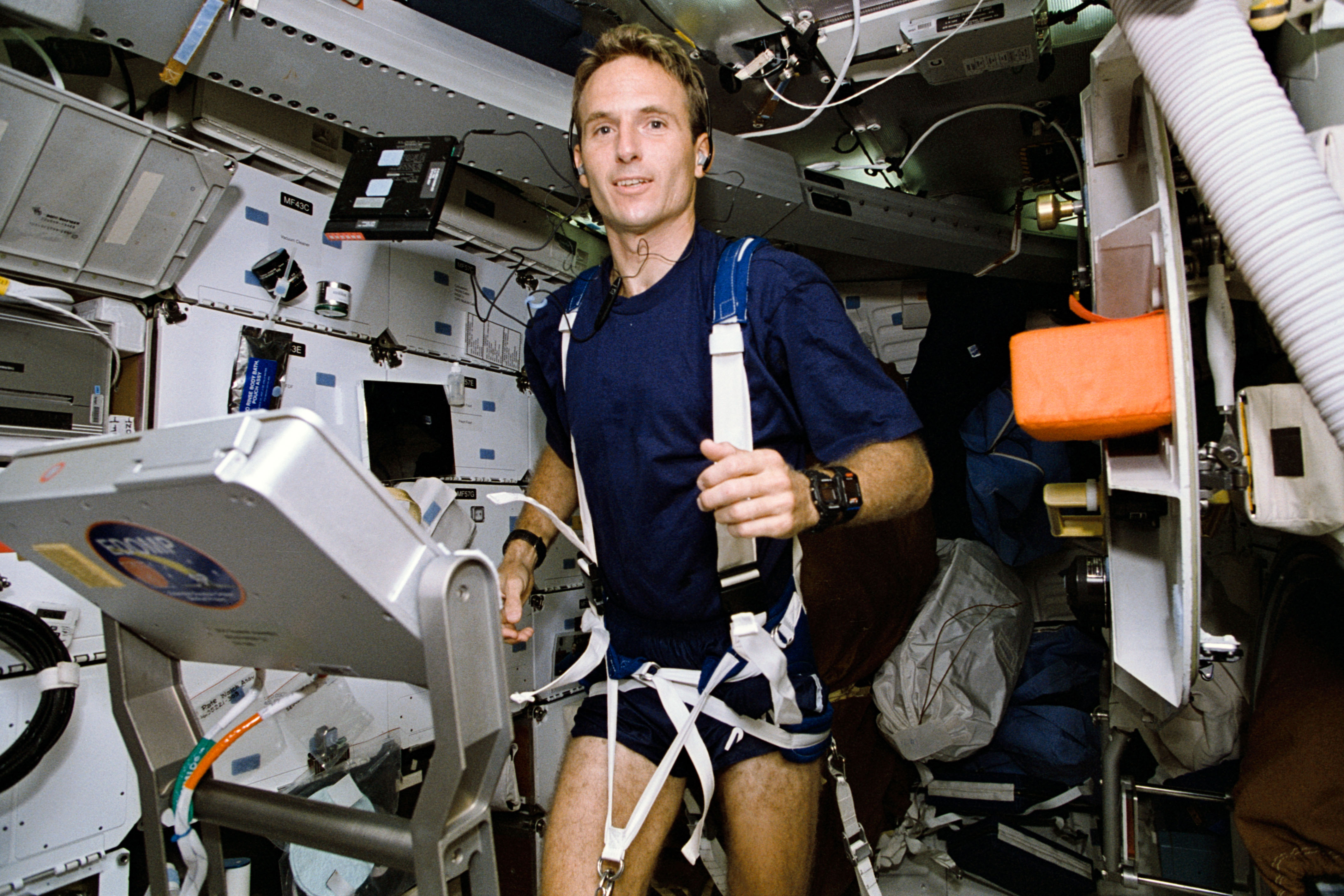
Former shuttle flier and Mir resident Jerry Linenger—who holds the unenviable reputation of becoming the first “Hog” in history to fly into space—turns 60 today (Friday, 16 January). Selected by NASA in March 1992, Linenger’s six years with the agency saw him embark on two space missions, firstly aboard Shuttle Discovery on STS-64 in September 1994 and subsequently as the fourth long-duration U.S. resident of Russia’s Mir space station, between January-May 1997, during which time he and his crewmates endured an on-board fire which threatened to severely test the partnership between the two nations. By the time he returned to Earth, he had become the first U.S. citizen to perform an EVA from a non-U.S. spacecraft in a non-U.S. space suit and had also completed the longest single space mission (132 days) by any U.S. astronaut at that time. In fact, Linenger remained on the list of Top Ten most flight-experienced American spacefarers until February 2003 and even today retains a place in the Top Fifty most seasoned U.S. spaceflight veterans.
Jerry Michael Linenger was born on 16 January 1955 and raised in Eastpointe, Mich. After leaving high school, he entered the Naval Academy to study biosciences and earned a degree in 1977. Additional academic credentials followed in rapid succession: a doctorate in medicine from Wayne State University School of Medicine in 1981, a master’s degree in systems management from the University of Southern California in 1988, and finally a master’s in public health policy from the University of North Carolina at Chapel Hill and a PhD in epidemiology from the University of North Carolina, both in 1989. “Whenever anyone teases me about the number of academic degrees I have accrued,” Linenger wrote in his 2000 autobiography, Off the Planet, “I generally respond that I was a rather slow learner—I had to keep going to school until I got it right!”
As a physician, he completed his surgical internship, his aerospace medicine training, and his flight surgeon instruction, and served as medical advisor to Admiral Jim Service, commander of Naval Air Forces of the U.S. Pacific Fleet. Linenger was selected as a shuttle mission specialist candidate by NASA in March 1992, part of the 14th group of astronauts, which found themselves wryly dubbed “The Hogs.” According to Canadian astronaut Chris Hadfield—a contemporary of Linenger, writing in his 2013 autobiography, An Astronaut’s Guide to Life on Earth—the nickname derived from the Muppets skit Pigs in Space and from the group’s decision to sponsor a pot-bellied pig at the Houston Zoo.
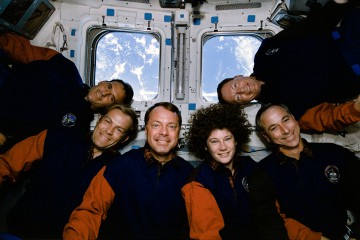
By the fall of 1993, the first member of Group 14, Steve Smith, was assigned to shuttle mission STS-68, and by January of the following year several others had joined him in the training cycle. It was therefore expected that Smith would become the first of his class to actually fly into space. However, the tables turned on 18 August 1994, when Smith and his five crewmates experienced a harrowing on-the-pad shutdown of Endeavour’s three main engines, just 1.9 seconds before liftoff, and their flight was delayed by six weeks. This meant that Linenger—who had been named in February 1994 as a crewman on STS-64, scheduled to fly in September—would leapfrog Smith to become the first “Hog” in space.
Linenger joined Commander Dick Richards, Pilot Blaine Hammond, and Mission Specialists Mark Lee, Carl Meade, and Susan Helms, named to the flight in November 1993, but his assignment to STS-64 at such a late stage was unusual. In its official news release, NASA revealed that the decision “was made to more efficiently distribute the crew workload for this complex flight.” However, there existed another reason for the inclusion of Linenger, whose experience was expected to be “of great value in ongoing human physiology investigations.” One of those investigations was the need for medically-qualified astronauts to fly long-duration expeditions to Mir, and, coupled with Russia’s insistence that all NASA fliers must have prior flight experience, Linenger was slotted into the earliest available shuttle mission. When he launched aboard Discovery on 9 September 1994, Linenger also established a new shuttle-era record of less than 30 months between admission into the astronaut corps and his first liftoff.
One of his responsibilities during the 11-day STS-64 flight was to provide “intravehicular” support for Lee and Meade during their six-hour EVA. Although he would go on to make a spacewalk later in his own career, for Linenger the sight of his crewmates floating against the serene backdrop of Earth and the ethereal blackness of space was unforgettable. “The one thing I’ll always picture from STS-64 is watching Carl Meade and Mark Lee out there testing the new jetpacks,” he told a Smithsonian interviewer, “spinning on the end of the arm, totally free of the Shuttle and the Earth below them. It’s one of those pictures that’s pretty much imprinted in my brain, even though I wasn’t doing the spacewalk.”
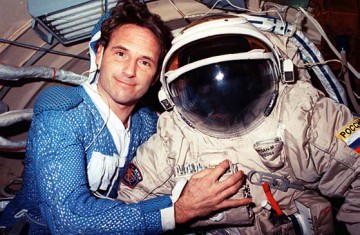
Within months of returning from his first mission, Linenger arrived at the Star City cosmonauts’ training center, on the forested outskirts of Moscow, to begin training for NASA’s third long-duration flight to Mir. It was expected that he would launch aboard STS-79 in August 1996 to relieve fellow astronaut Shannon Lucid and go on to spend four months aboard the Russian orbital outpost, before handing over the baton to astronaut John Blaha on STS-81 in December. The idea of a given astronaut backing up a mission, skipping the next to offer some respite, and then serving as prime on the third was in NASA’s planning from the outset, and the Russians also disliked “consecutive” assignments.
All that appears to have changed in the fall of 1995, when astronauts Scott Parazynski and Wendy Lawrence—who were intended to backup Linenger and Blaha, respectively—were removed from training, because they were deemed too tall and too short to fit the Soyuz descent module. Coupled with a relative paucity of volunteers from within the astronaut office, their departure appears to have forced NASA to fly astronauts consecutively, with a given astronaut backing up one expedition and flying the next. Additionally, the sequence in which the astronauts would fly was changed, with Blaha launching first on STS-79 and Linenger to follow on STS-81. “John and I switched positions in the sequence,” recalled Linenger in Off the Planet, “in order for me to do a spacewalk.”
Delays to the shuttle fleet in 1996 caused STS-79 to move to September and Linenger’s launch on STS-81 correspondingly slipped into the following year. At length, on 12 January 1997, he rocketed into orbit aboard Atlantis with his crewmates, Commander Mike Baker, Pilot Brent Jett, and Mission Specialists Jeff Wisoff, John Grunsfeld, and Marsha Ivins, arriving at Mir two days later. As the hatches between the two spacecraft opened, Linenger remembered “an uninhibited laugh” from Blaha, followed by “bedlam … as the six of us blundered our way through the hatch and bumped heads with the much more graceful threesome of Mir occupants. The scene was one of hugs, shouts, mixed language and laughter, feet dangling in all directions. Nine spacefarers embracing and floating in every which way.”
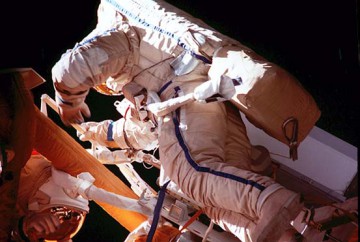
In their five days together, Blaha and Linenger performed a changeover and his first perspective of Mir was that it resembled an old, musty wine cellar, with its warren-like collection of cluttered passages. After Atlantis departed, Linenger was left with his Russian crewmates, Valeri Korzun and Aleksandr Kaleri, who had been aboard Mir since August 1996 and were due to return to Earth in February. Three weeks after Linenger’s arrival, Soyuz TM-25 arrived with Russian cosmonauts Vasili Tsibliyev and Aleksandr Lazutkin, together with German cosmonaut Reinhold Ewald, and it was during their two weeks together that a near-disaster hit Mir and marked the start of one of the most troubled years in the partnership between the two former Cold War adversaries.
On 23 February, Russia celebrated “Defender of the Fatherland Day” in honor of its armed forces and the six men gathered at the dinner table in Mir’s base block for a celebratory meal. At one point, Linenger headed back to the station’s Spektr module to don electrodes for a sleep study, whilst Lazutkin excused himself and headed into the Kvant-1 module to change an Elektron oxygen generator. He removed the old “candle,” fitted a new one, and was about to return to the base block, when he was startled by sparks emerging from the top. Within seconds, the relatively innocuous first perspective became more threatening, when the sparks changed into a small column of pinkish-orange flame, reaching 12 inches (30 cm).
Immediately, Korzun—the commander of Mir at the time—entered Kvant-1 to assist his crewmate, but their efforts to switch off or smother the malfunctioning Elektron proved fruitless. Korzun dismissed everyone from Kvant-1 and told Tsibliyev, Lazutkin, and Ewald to prepare their Soyuz TM-25 spacecraft for an emergency evacuation. Unfortunately, the Soyuz TM-24 vehicle, which he, Kaleri and Linenger would use, was docked at the aft end of Kvant-1 and could not be reached until the fire had been extinguished.
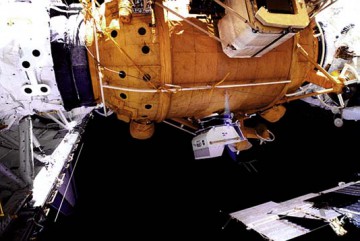
By now, thick black smoke was beginning to pour into Mir’s base block. The fire alarm was activated and triggered an automatic shutdown of the station’s ventilation system, in order to prevent smoke from being blown into the neighboring modules. Linenger returned from Spektr and the entire crew donned oxygen masks as Korzun finally brought the fire under control. The six men then assembled in the Kvant-2 module—where air conditions were cleanest—and Linenger set up a makeshift first-aid station, distributing rubber filter masks and treating minor and second-degree skin burns. Despite some bronchial irritation, dry throats and a small burn on Korzun’s hand, none of the crew was seriously harmed, but the fire left a film of grime on many surfaces, which required several hours to remove.
In total, the crew remained on oxygen masks for 2.5 hours. “Although we could talk to each other, our words were muffled because of the masks,” Linenger wrote in Off the Planet. “Hand signals proved universally understandable and eliminated the need to mentally translate from Russian to German or English.” Much to NASA’s dismay, its officials were not informed about the fire for 12 hours. A crack in the Elektron’s shell had allowed its contents to leak into the outer hardware and no less than three fire extinguishers were required to put it out. In turn, this increased the atmospheric humidity and temperature and the crew were ordered to take vitamin tablets and milk products. Linenger performed a toxicological test of Mir and declared the air to be satisfactory. The incident would factor strongly in U.S. Congressional debates, later in 1997, about the safety of the aging Russian station to support American astronauts.
The troubles were not over. In March, following the safe return to Earth of Korzun, Kaleri, and Ewald, the crew was faced with a near-miss from the Progress M-33 resupply craft. It was expected that Tsibliyev would use the Russian-built TORU remote-controlled apparatus to guide it to a smooth docking at the Kvant-1 aft port, but the system failed to present a constant image of the incoming Progress on his display screen. “I flew to a window that faced the same general direction as the window Sasha [Lazutkin] and Vasili were using and did so just in time to see the Progress go screaming by us,” Linenger wrote. “Fearing the very real possibility of a collision, instinct told me to brace for impact. I gritted my teeth, held my breath, and hoped for a miss. Although the Progress had disappeared from view under the edge of the window, I quickly calculated that, having felt nothing, the Progress must have missed hitting the base block.” It turned out that the spacecraft had passed Mir at a distance of 720-750 feet (220-230 meters), and it was eventually decided to send it to a destructive re-entry in the atmosphere, rather than risk a second attempt to dock. In his later conversations with Linenger, Tsibliyev told him that the TORU had never once displayed a reliable image of the incoming spacecraft.
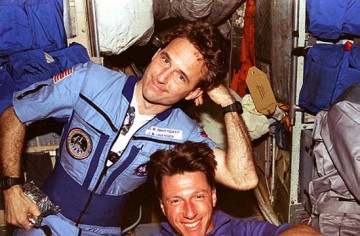
Equipment failures and repairs plagued the final weeks of Linenger’s mission, but on 29 April he became the first U.S. astronaut to participate in a spacewalk from a non-U.S. spacecraft, wearing a non-U.S. suit. The excursion was originally planned for earlier in the month, but ongoing problems with Mir’s angular rate sensors and the need to repair the troublesome oxygen system caused it to be delayed. Together with Tsibliyev, he spent four hours and 57 minutes in the vacuum of space, installing the Optical Properties Monitor (OPM) on the exterior of Mir’s Kristall module, and for Linenger it was the peak of his astronaut career.
As he emerged from the Kvant-2 airlock, he was immediately hit in the face by the intensity of orbital sunrise. “Even with my gold visor down, it was just blinding,” he recalled. “I was basically unable to see for the first three or four minutes.” At length, the two men set to work on their respective tasks. With Linenger positioned at the end of Mir’s pole-like Strela crane and Tsibliyev at its controls, they prepared for the installation of the dresser-sized OPM. “The and myself were then swung away on the tip of the pole,” Linenger wrote in one of his letters to his infant son, John. “Upon arrival [at Kristall], I attached the pole to its new location, we rejoined at my end and installed the OPM.” The spacewalkers then retrieved a pair of NASA sampling experiments and installed a dosimeter onto Kvant-2.
Linenger’s five hours in near-total vacuum were the first time since the Skylab era that an American astronaut had ventured outside an Earth-circling space station. “A spacewalk on the surface of a sprawling space station has a different flavor than one conducted inside the cargo bay of the space shuttle,” he wrote in one of his letters to John. He felt like a scuba-diver, but could not dispel the overwhelming sense that he was falling, and the sensation of tremendous orbital velocity was more apparent than it had been from inside Mir. “Crawling, slithering, gripping, reaching. You are not falling from the cliff; the whole cliff is falling and you are on it. You convince yourself that it is okay for the cliff and yourself on the cliff to be falling, because when you look out you see no bottom. You just fall and fall and fall. The sun sets swiftly. Blackness. Not merely dark, but absolutely black. You see nothing.” Even after adjusting his eyes, he could barely make out Tsibliyev’s silhouette.
Three weeks later, on 24 May 1997, Linenger returned smoothly to Earth aboard Atlantis with the STS-84 crew—Commander Charlie Precourt, Pilot Eileen Collins, and Mission Specialists Jean-Francois Clervoy, Carlos Noriega, Ed Lu, and Russia’s Yelena Kondakova—having left British-born U.S. astronaut Mike Foale as the next long-duration resident aboard Mir. Upon touchdown, Linenger had accrued a career total of 143 days in space and completed 2,091 orbits of Earth, making him the second most experienced male U.S. astronaut and the third most experienced U.S. spacefarer at that time. He retired from NASA in February 1998 to return to his native Michigan.
Although Linenger’s other achievement of having flown the longest single mission by an American would be broken later in 1997 by his successor, Mike Foale, he would nevertheless remain on the Top Ten list of the most experienced U.S. astronauts until February 2003, when Ken Bowersox nudged him out of the No. 10 spot. Even today, though, with long-duration expeditions more commonplace aboard the International Space Station (ISS), Linenger still retains a place within the Top Fifty most seasoned U.S. spacefarers. And although other Americans have spacewalked in Russian suits—Mike Foale, Dave Wolf, Frank Culbertson, Dan Bursch, Carl Walz, Peggy Whitson, Mike Fincke, Leroy Chiao, John Phillips, Bill McArthur, Jeff Williams, Mike Lopez-Alegria, and, most recently, Mike Barratt in June 2009—the achievement of Jerry Linenger is that he was first.
Want to keep up-to-date with all things space? Be sure to “Like” AmericaSpace on Facebook and follow us on Twitter: @AmericaSpace




Happy Birthday Jerry!